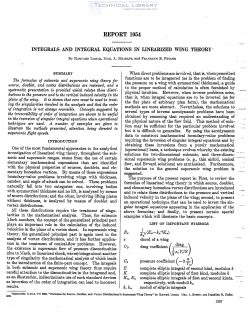naca-report-1054

- Version
- 171 Downloads
- 3.40 MB File Size
- 1 File Count
- September 1, 2016 Create Date
- September 1, 2016 Last Updated
National Advisory Committee for Aeronautics, Report - Integrals and Integral Equations in Linearized Wing Theory

The formulas of subsonic and supersonic wing theory for
source, doublet, and. vortex distributions are reviewed, and a
systematic presentation is provided which relates these distri-
butions to the pressure and to the uertical induced velocity in- the
plane of the wing. It is shown that care must be used in treat-
ing the singularities ineolred in the analysis and that the order
of integration is not always reeersible. Concepts suggested by
the iiverersibility of order of integration are shown to be useful
in the inrersion of singular integral equations when operational
techniques are used. A number of examples are given to
illustrate the methods presented, attention being directed to
supersonic flight speeds.
One of the most fundamental approaches to the analytical
investigation of linearized wing theory, throughout the sub—
sonic and supersonic rang . stems from the use of certain
elementary mathematical expressions that are identified
with the physical properties of sources, doublets, and ele—
mentary horseshoe vortices. By means of these expressions
boundary-value problems involving wings with thickness,
camber, and angle of attack can be solved. These problems
naturally fall into two categories: one, involving bodies
with symmetrical thickness and no lift, is analyzed by means
of source distributions; and the other, involving lifting plates
without thickness, is analyzed by means of doublet and
vortex distributions.
All these distributions require the treatment of singu—
larities in the mathematical analysis. Thus, for subsonic
Mach numbers, the concept of the generalized principal part
plays an important role in the calculation of the induced
velocities in the plane of a vortex sheet. In supersonic wing
theory, the generalized principal part is main used in the
analysis of vortex distributions, and it has further applica-
tion in the treatment of conical-flow problems. However,
the existence in supersonic flow of pressm'e discontinuities
(due to Mach, or linearized shock, waves) brings about another
type of singularity the mathematical analysis of which leads
to the introduction of the finite-part concept. The integrals
in both subsonic and supersonic wing theory thus require
careful attention to the discontinuities in the integrand and,
as an illustration, indiscriminate use of such standard devices
as inversion of the order of integration can lead to incorrect
results.
| File | Action |
|---|---|
| naca-report-1054 Integrals and Integral Equations in Linearized Wing Theory.pdf | Download |

Comment On This Post